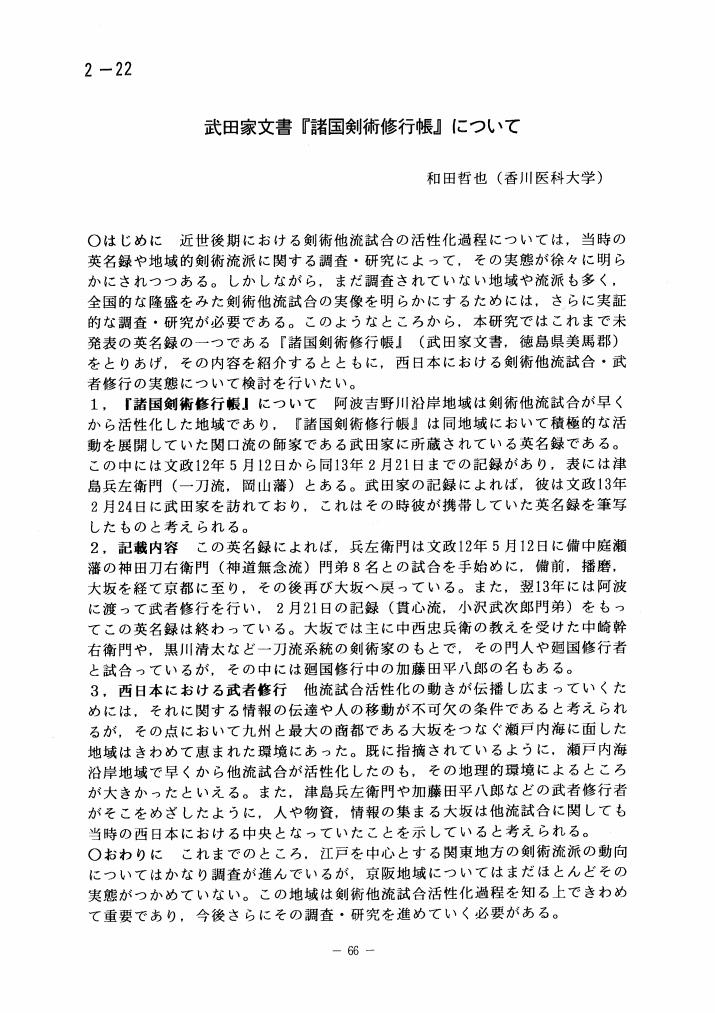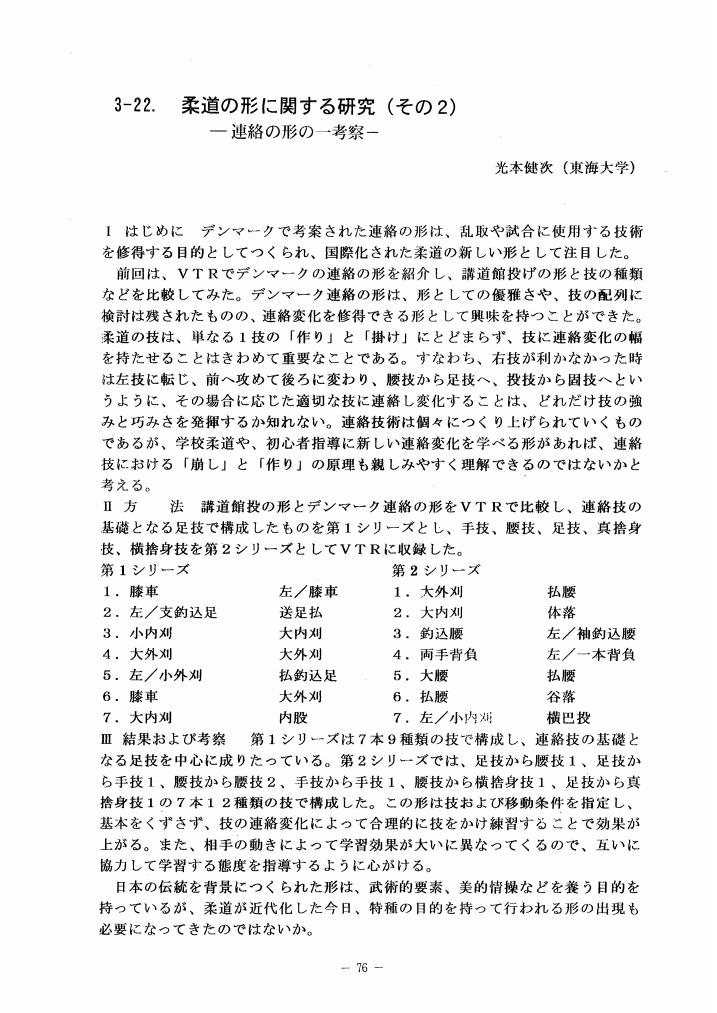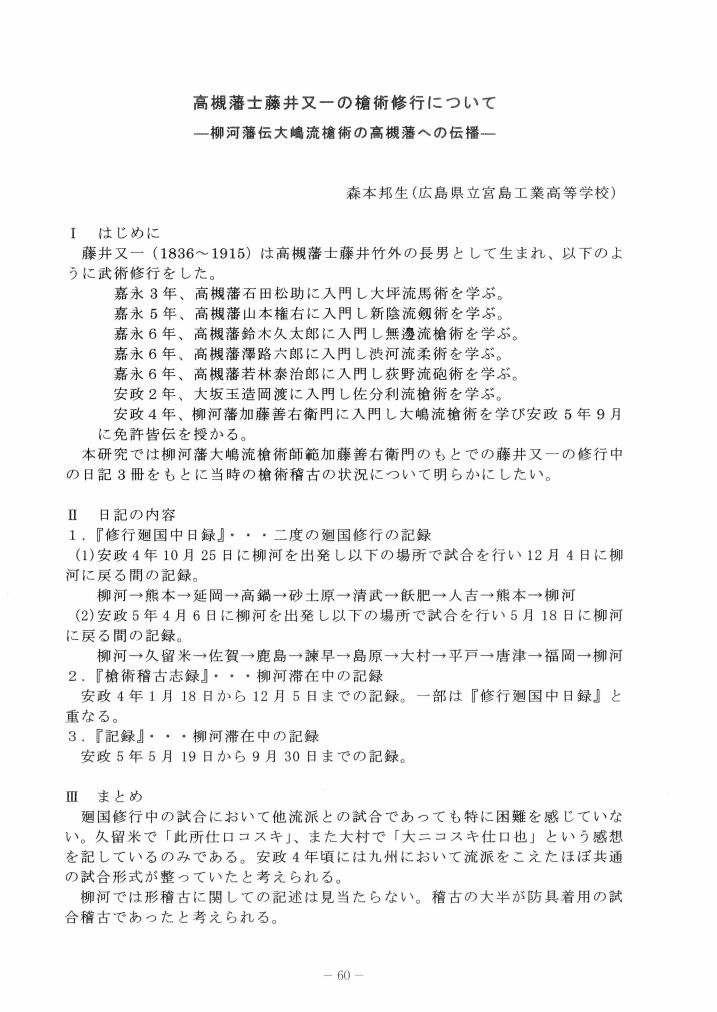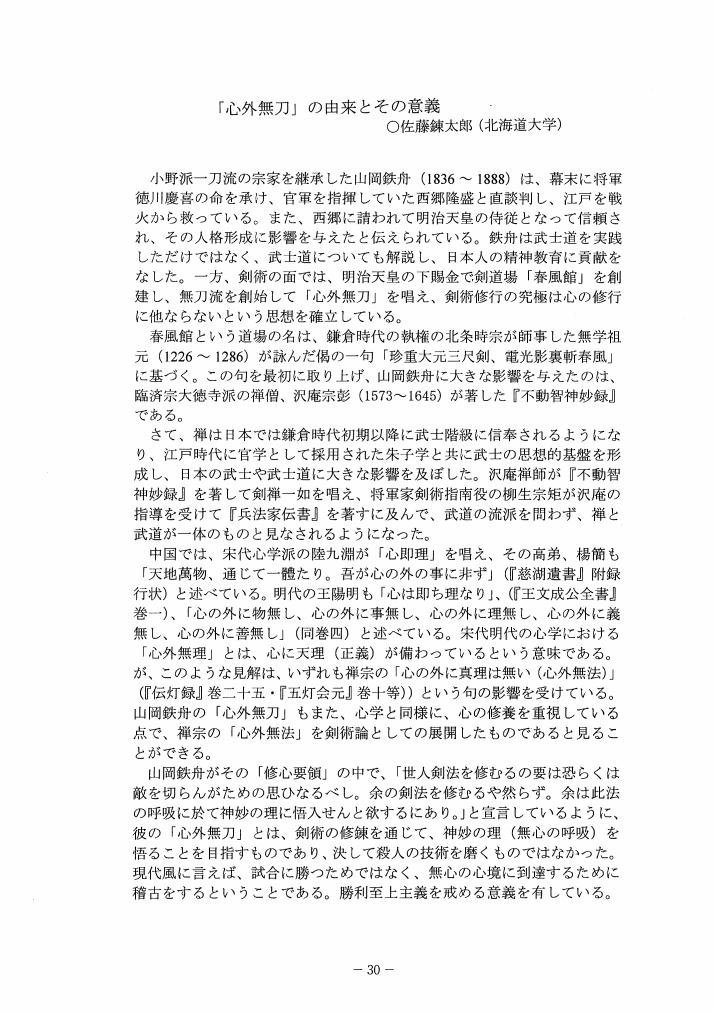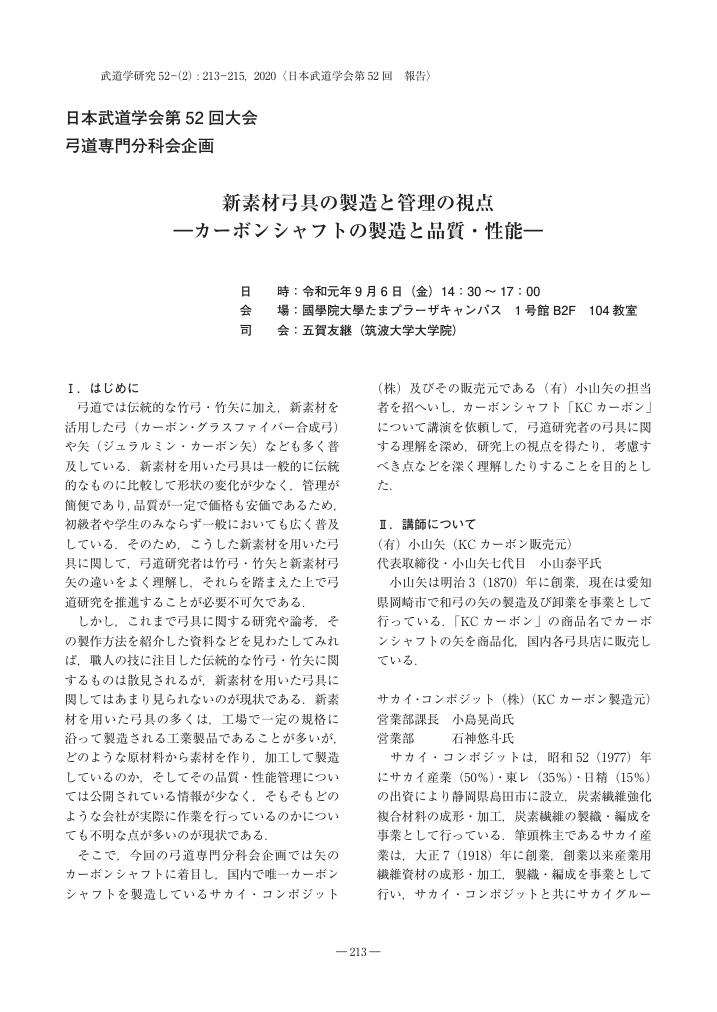1 0 0 0 OA 武田家文書『諸国剣術修行帳』について
- 著者
- 和田 哲也
- 出版者
- 日本武道学会
- 雑誌
- 武道学研究 (ISSN:02879700)
- 巻号頁・発行日
- vol.25, no.Supplement, pp.66, 1992 (Released:2012-11-27)
1 0 0 0 OA 武道とポピュラー文化
- 著者
- 井上 俊
- 出版者
- 日本武道学会
- 雑誌
- 武道学研究 (ISSN:02879700)
- 巻号頁・発行日
- vol.50, no.Supplement, pp.S_8-S_9, 2017 (Released:2019-01-23)
1 0 0 0 OA 競技特性からみた剣道におけるスポーツ傷害の分析
- 著者
- 和久 貴洋 河野 一郎 中村 充 三輪 一義 香田 泰子 香田 郡秀 佐藤 成明
- 出版者
- 日本武道学会
- 雑誌
- 武道学研究 (ISSN:02879700)
- 巻号頁・発行日
- vol.24, no.1, pp.45-51, 1991-07-31 (Released:2012-11-27)
- 参考文献数
- 23
- 被引用文献数
- 2
The purpose of this study was to examine the measures to prevent injuries and to improve performance of Kendo by analyzing injuries due to Kendo from practice condition and athletic specificity. The findings were collected from a survey by questionnaire on injuries due to Kendo. The following results were obtained. Thirty-eight out of forty-four Kendo players (college players) had experience in injuries due Kendo in the past. Most Kendo players were injuried in college. Most Kendo players were injuried during practice of Kendo (Jigeiko, Kakarigeiko, or Shiaigeiko) in the middle or the latter half at practice of Kendo. Most of injuries were myorrhexis, plasmotomy of the tendon, tendovaginitis, sprain, stress fracture, spondylolysis, lumbago and bruise. The higher occurence parts of injuries due to Kendo were ankle and wrist joints, the tendo calcaneus (Achilles), crus, thigh and regio lumbalis. Many injuries of crus, the tendon of Achiles and wrist joint were in the left, although injuries of ankle joint were in the right. Fiftysix percent of all injuries were caused by fatigue and the fatigue was occured by Tobikomi action, Suburi action, or Taiatari during Jigeiko and Kakarigeiko in the latter half at practice of Kendo. These were concluded that injuries due to Kendo can be prevented by master of correct Datotsu technique, the measure to fatigue, forming appropriate training plan and the systematization of staff for first aid and that the weight training to the higher occurence parts of injuries due to Kendo was needed for prevention of injuries and improvement in performance of Kendo.
1 0 0 0 OA 柔道の形に関する研究(その2)―連絡の形の一考察―
- 著者
- 光本 健次
- 出版者
- 日本武道学会
- 雑誌
- 武道学研究 (ISSN:02879700)
- 巻号頁・発行日
- vol.31, no.Supplement, pp.76, 1998 (Released:2012-11-27)
1 0 0 0 OA 高槻藩士藤井又一の槍術修行について ―柳河藩伝大嶋流槍術の高槻藩への伝播―
- 著者
- 森本 邦生
- 出版者
- 日本武道学会
- 雑誌
- 武道学研究 (ISSN:02879700)
- 巻号頁・発行日
- vol.43, no.Supplement, pp.60, 2010 (Released:2014-04-04)
1 0 0 0 OA 日中戦争以降における武道の戦技化の起源とその背景:武道振興委員会の審議過程の分析
- 著者
- 中嶋 哲也
- 出版者
- 日本武道学会
- 雑誌
- 武道学研究 (ISSN:02879700)
- 巻号頁・発行日
- vol.49, no.2, pp.95-107, 2016-11-30 (Released:2018-03-12)
- 参考文献数
- 15
Only a few historical studies have examined Japan’s martial arts during the Second Sino-Japanese War of 1937-1945. Those studies that do exist tend to focus on the controversy surrounding “sengika,” or the militarization of martial arts. Extant research has documented that sengika was recommended by the Martial Arts Promotion Committee (MAPC), which was instituted by the government as an advisory body in December 1939. Previous research indicates that the commissioners of the MAPC were not universally enthusiastic about sengika. The purpose of this study is to delineate the process by which internal opposition to sengika was transformed into support on the committee.This research has yielded the following results: the commissioners originally critical of the sengika came to concur that martial arts could have useful military applications. They emphasized the combative effectiveness of martial arts that is not evident in sport-oriented practices, and aimed to distinguish between the martial arts and sports with the intention of protecting the uniqueness of Japanese martial arts. This stance, however, prevented them from offering a protest against sengika.One area for further investigation is why those officials intent on preventing the Westernization of martial arts (making them into sports) chose to make the combative effectiveness of martial arts their central issue. Subsequent research on the role of martial arts during wartime will need to address in greater detail this effort to prevent the treatment of martial arts as sport.
1 0 0 0 OA シンポジウム 剣道人口減少の実態とその原因を探る
- 出版者
- 日本武道学会
- 雑誌
- 武道学研究 (ISSN:02879700)
- 巻号頁・発行日
- vol.27, no.Supplement, pp.8-12, 1994 (Released:2012-11-27)
- 著者
- 嘉手苅 徹
- 出版者
- 日本武道学会
- 雑誌
- 武道学研究 (ISSN:02879700)
- 巻号頁・発行日
- vol.49, no.2, pp.121-136, 2016-11-30 (Released:2018-03-12)
- 参考文献数
- 107
The aim of this paper is to clarify the origins of the modern kata in karate-do by examining the 15 kinds of kata, or forms, described by Gichin Funakoshi in his major study that appeared in three volumes: Ryūkyū Kenpō Karate (1922); Rentan Goshin Karatejutsu (1925); and Karate-dō Kyōhan (1935), in which the term “toudi” was changed to “karate”.The kata are divided into three phases: “initial movement”, “development of technique”, and “closing movement”. The first and last of these phases are most important when trying to understand the similarities and differences in terms of movements, and when seeking to comprehend the styles of, and transitions in, kata.When demonstrating karate-do, the principle of “begin with rei; end with rei” was established by adapting modern Japanese educational manners to both the “initial movement” and “closing movement”. The presence of onlookers at a demonstration had a particularly significant effect not only on these two phases, but also on the transformation of the symbolic movements made. One may therefore conclude that karate-do was transformed into a new system of techniques. The influence of modern physical education can be seen in the concept of group practice, in the way performers occupy a space and stand to attention, and in the teaching method involving the giving of orders to performers.It is clear that Funakoshi’s system was not modeled on any Chinese exemplar. He makes no reference to Chinese martial arts and manners in his 15 kinds of kata, nor is there any mention of these three phases of kata in the Bubishi, a study of Chinese martial arts that was widely known in Okinawa during the Taisho and Showa eras.For these reasons, we must conclude that Funakoshi based his karate-do on a Ryukyu style of karate that belonged to a post-Chinese culture, and founded it to promote modern physical education and Japanese martial arts.
1 0 0 0 子供(小学生)の柔道指導について
1 0 0 0 OA 「心外無刀」の由来とその意義
- 著者
- 佐藤 錬太郎
- 出版者
- 日本武道学会
- 雑誌
- 武道学研究 (ISSN:02879700)
- 巻号頁・発行日
- vol.39, no.Supplement, pp.30, 2006 (Released:2012-11-27)
1 0 0 0 中学校武道必修化への対応<BR>―相撲の指導案作成に向けて―
- 著者
- 満留 久摩 桑森 真介
- 出版者
- 日本武道学会
- 雑誌
- 武道学研究 (ISSN:02879700)
- 巻号頁・発行日
- vol.43, pp.S21, 2010
1 0 0 0 空手の組手における間合いに関する研究
- 著者
- 大德 紘也
- 出版者
- 日本武道学会
- 雑誌
- 武道学研究 (ISSN:02879700)
- 巻号頁・発行日
- vol.48, pp.S_100, 2015
1 0 0 0 柔道大内刈りにおける初心者の運動特性
- 著者
- 坂内 志礼 三戸 範之
- 出版者
- 日本武道学会
- 雑誌
- 武道学研究 (ISSN:02879700)
- 巻号頁・発行日
- vol.42, pp.80, 2009
1 0 0 0 OA 弓道における「早気」に関する研究
1 0 0 0 ガッツポーズに関する意識調査 〜武道に携わる大学生を対象として〜
1 0 0 0 OA 剣道の中段の構えにおける左足先方向が足底力と正面打撃動作に及ぼす影響について
- 著者
- 横山 直也 百鬼 史訓
- 出版者
- 日本武道学会
- 雑誌
- 武道学研究 (ISSN:02879700)
- 巻号頁・発行日
- vol.16, no.2, pp.18-26, 1984-02-29 (Released:2012-11-27)
- 参考文献数
- 31
- 被引用文献数
- 2
The purpose of this study is to investigate the influence of the left foot outward angle in Chudan-no-kamae on the Shomen-uchi.A force platform was used together with 16 mm cine camera to investigate synchronously the mechanics of take-off motion during the Shornen-uchi in Kendo.The records of the force components of foot pressure on the floor of the male Kendo players were obtained at the take-off motion during Shomen-uchi. Subsequently, the records were taken with the body movements shown in 16 mm film.The subjects for this study were 9 male students of the Tsukuba University,20 to 23 years of age,12 to 15 years of experience and 3 to 4 dan degree.The results obtained are as follows:1. The leftward and the backward components of foot force increase with the change of the left foot angle (from 0° to 50°). The tendency above mentioned is clearly observed over 30° and especially at 50°.2. The larger the left foot angle at Chudan-no-kamae is, the more the maximum magnitude of leftward force (Fx) increases. On the contrary, both of the backward (Fy) and vertical (Fz) forces during take-off motion at Shomen-uchi decrease.3. A larger and sharper peak in the force curve of the backward and vertical components is observed at the angle under 20° and especially usual foot position.4. The angle of forward inclination of body (∠f) decreases gradually with the increase of the left foot angle. The angle of trunk (∠a) decreases as the result of an inadequate left foot action, which causes delay of the posture recovering after striking motion.
1 0 0 0 OA 新素材弓具の製造と管理の視点―カーボンシャフトの製造と品質・性能―
- 著者
- 五賀 友継
- 出版者
- 日本武道学会
- 雑誌
- 武道学研究 (ISSN:02879700)
- 巻号頁・発行日
- vol.52, no.2, pp.213-215, 2020-03-31 (Released:2020-08-26)
1 0 0 0 OA 國士館専門学校における武道教員養成の研究
- 著者
- 佐藤 宏拓穣
- 出版者
- 日本武道学会
- 雑誌
- 武道学研究 (ISSN:02879700)
- 巻号頁・発行日
- vol.39, no.2, pp.27-37, 2006-12-31 (Released:2012-11-27)
- 参考文献数
- 62
本研究は,昭和前半期における武道教員養成の実態を,國士館専門学校の場合を明らかにする。昭和前半期における武道教員の養成は,文部省に認可されていた東京高等師範学校(以下,高師と略記する),大日本武徳会武道専門学校(以下,武専と略記する),そして國士館の3校が行っていた。國士館は,昭和4(1929)年,文部省により専門学校として設置が認可された。昭和8(1933)年,剣道・柔道に対して文部省は,中等学校教員資格の免許を無試験で与えられることになった。
